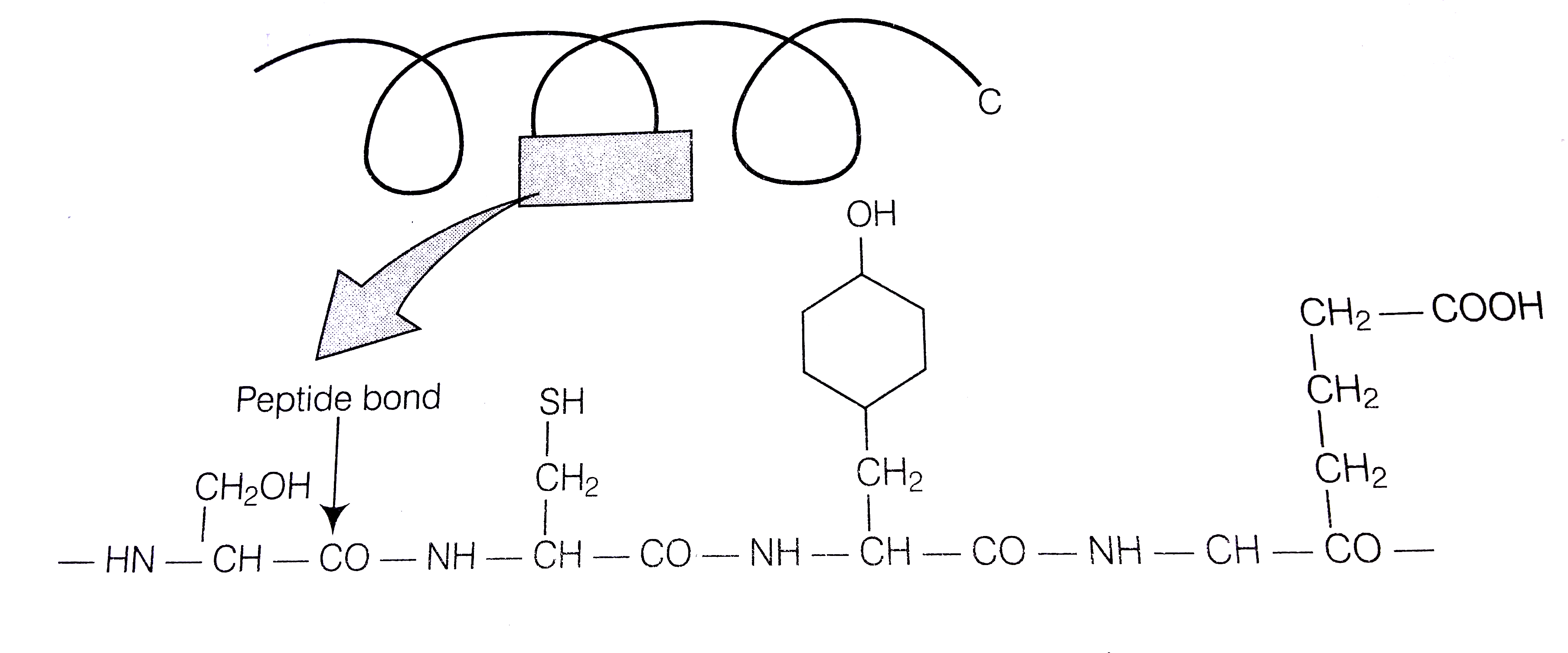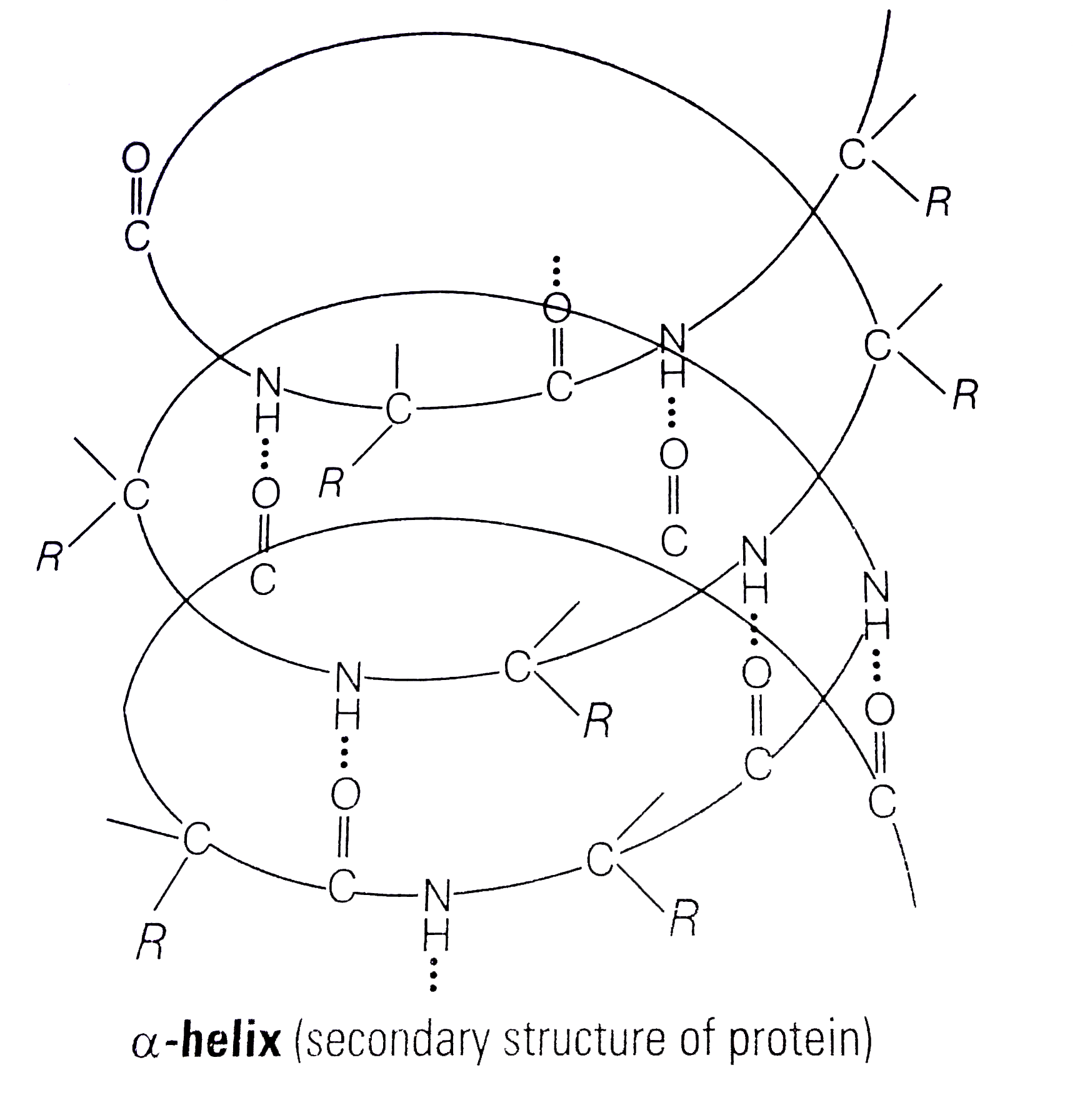Schematically represent primary, secondary and tertiary structures of a hypothetical polymer say for example a protein.
Video Solution
Text Solution
Proteins are the large-sized, heteropolymeric macromolecules having one or more polypetides (chains of amino acid).
Primary Structure The primary structure of a protein is the linear sequence of amino acid strutural units and partially comprises its overall biomolecular strucutres. The amino acids are linked together in a sequence by peptide bonds.
In the primary strucutre of protein initiate from an amino-terminal (N) to the carboxyl terminal (C) end,

Secondary Structure It is a three dimensional form of local segments of bipolymers such as proteins. Secondary structure of proteins is defined by hydrogen bonds between backbone amino and carboxyl groups. Mainly secondary structure in proteins possess two forms, i.e., α-helix and β-pleated sheet.
α-helix is a polypeptide chain spirally coiled to form a right handed helix. This helix may be coiled regularly at places and at some places randomly coiled. The hetix is stabilised by many hydrogen bonds which are formed between - CO of one amino acid and - NH group of next fourth amino acid.
β-pleated sheets two or more polypeptide chains are joined together by intermolecular hydrogen bonds to produce a sheet like structure instead of fibre as in α-helix. The polypeptide strands in a sheet may run parallel in same direction, e.g .. keratain or in opposite direction called antiparallel β-sheet, e.g., fibroin.

Tertiary structure involves interactions that are caused by the bending and folding of α-helix or β-sheets leading to the formation of rods, spheres of fibres, Such interactions are typically conferred by H-bonds, ionic bonds, covalent bonds, van der Waat's interactions and hydrogphobic interactions or disulphide linkages. It gives the protein a three dimensional conformation.

|
Updated on:21/07/2023
Related Playlists
- BOOK - NCERT EXEMPLAR ENGLISHCHAPTER - BIOMOLECULES EXERCISE - Long Answer Type Questions5videos
BIOMOLECULES
- BOOK - NCERT EXEMPLAR ENGLISHCHAPTER - BIOMOLECULES EXERCISE - Very Short Answer Type Questions7videos
BIOMOLECULES
- BOOK - NCERT EXEMPLAR ENGLISHCHAPTER - BIOLOGICAL CLASSIFICATIONEXERCISE - Long answer5videos
BIOLOGICAL CLASSIFICATION
- BOOK - NCERT EXEMPLAR ENGLISHCHAPTER - Body Fluids and Circulation EXERCISE - LONG ANSWER TYPE Q5videos
Body Fluids and Circulation
Similar Practice Problems
- Question 1 - Select One
The primary structure of a protein molecule has
Atwo endsBone endCthree endsDno ends. - Question 1 - Select One
Primary structure of protein is due to
Asequence in which α-amino acids are linked to one anotherBsequence in which amino acid of one polypeptide chain are joined to other chainCthe folding patterns of polypeptide chainsDthe pattern in which the polypeptide chains are arranged.
Similar Questions
What are primary, secondary and tertiary roots ?
View SolutionIn the primary structure of protein
View SolutionThe primary structure of a protein molecule has
View SolutionPrimary structure of protein is due to
View SolutionWhat is meant by tertiary structure of proteins?
View SolutionWhat is meant by tertiary structure of proteins?
View SolutionThe tertiary structure of proteins can be destroyed by
View SolutionThe tertiary structure of proteins can be destroyed by
View Solution

